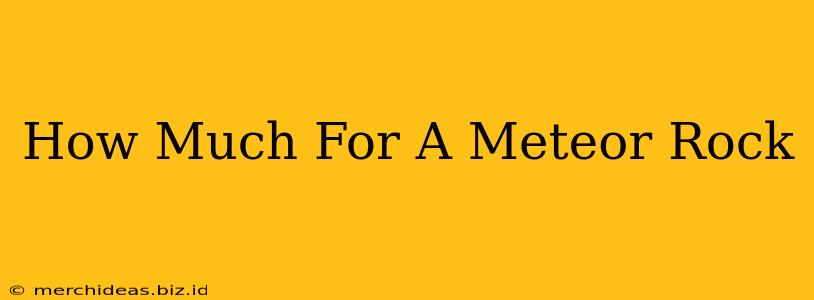The price of a meteor rock, or meteorite, can vary wildly, depending on several key factors. Are you wondering, "How much for a meteor rock?" Let's delve into the factors influencing the value of these celestial treasures.
Factors Affecting Meteorite Prices
Several factors determine a meteorite's value, making it a fascinating and sometimes lucrative collectible:
1. Type of Meteorite:
This is arguably the most crucial factor. Meteorites are categorized into three main types:
-
Iron meteorites: These are largely composed of iron and nickel, often exhibiting beautiful Widmanstätten patterns when etched. Their prices are generally more affordable than stones, making them attractive to beginner collectors. Expect to pay anywhere from a few dollars per gram for common iron meteorites to hundreds or even thousands for rarer specimens with exceptional features.
-
Stony meteorites: These are predominantly silicate minerals. Chondrites, the most common type of stony meteorite, contain chondrules—small spherical particles formed in the early solar system. Prices range from a few dollars to several hundred dollars per gram, depending on the type and condition. Achondrites, a less common type, often command higher prices due to their rarity.
-
Stony-iron meteorites: These meteorites are a mix of both silicate minerals and iron-nickel, representing a less common type. Their unique composition frequently results in higher prices. Pallasites, a visually stunning variety, often fetch premium prices due to their olivine crystals embedded in nickel-iron.
2. Rarity and Origin:
The rarity of a specific meteorite significantly influences its price. Meteorites recovered from well-known falls (documented events where meteorites were observed falling) are often more valuable than those found randomly. Meteorites from specific locations, such as the moon or Mars, are extremely rare and highly prized, commanding extraordinarily high prices.
3. Size and Weight:
Larger specimens naturally command higher prices than smaller ones, all other factors being equal. A large, complete meteorite is a more impressive and valuable specimen compared to a small fragment.
4. Condition and Aesthetics:
The condition of a meteorite affects its value. A well-preserved meteorite with minimal terrestrial weathering or damage will be worth more than a damaged or heavily weathered one. The aesthetic appeal also plays a role; a meteorite with striking visual characteristics, such as exceptional Widmanstätten patterns, will be more valuable.
5. Authentication and Documentation:
Proper authentication is crucial. Reputable meteorites are often accompanied by certificates of authenticity from recognized meteorite organizations or experts. Documentation detailing the recovery location, date, and type of meteorite significantly enhances its value. Beware of fraudulent sellers.
How Much Can You Expect to Pay?
The price range for meteorites is vast. You can find small fragments of common meteorites for a few tens of dollars. However, rare and significant specimens, particularly those from the Moon or Mars, can cost tens of thousands or even hundreds of thousands of dollars.
Remember: Always buy meteorites from reputable dealers with a proven track record and who provide certificates of authenticity. Be wary of unusually cheap offers, as these may indicate fakes. Thorough research is key to ensuring a genuine and valuable addition to your collection.
Do your research, learn about different types of meteorites, and carefully consider the factors discussed above before making a purchase. Happy hunting!
